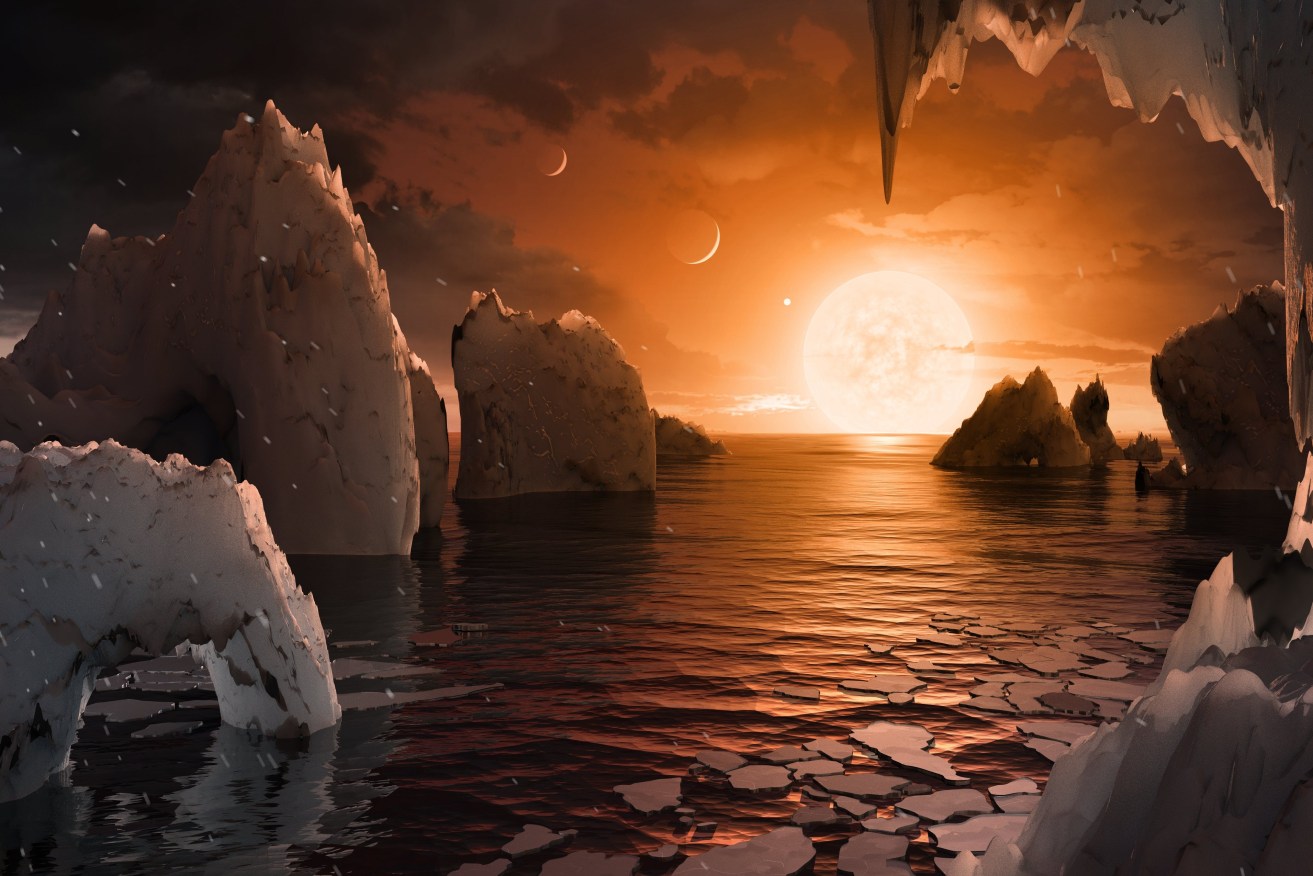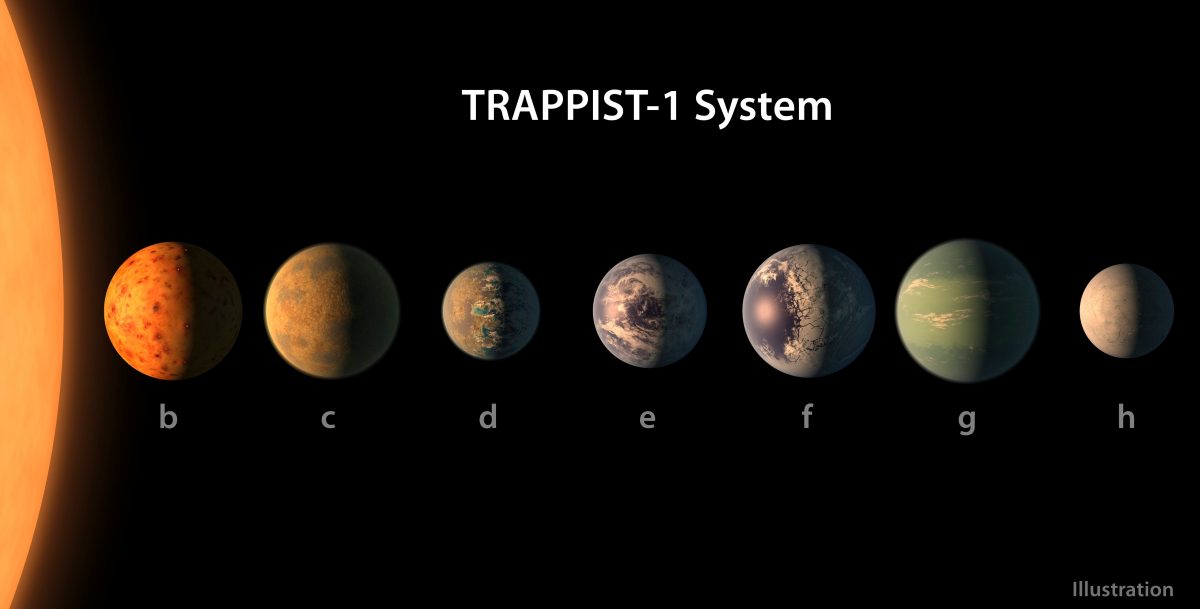Astronomers find seven Earth-sized planets
Astronomers have found a nearby solar system with seven Earth-sized planets, three of which circle their parent star at the right distance for liquid surface water, raising the prospect of life.

An artist's imagining of what it would be like to stand on the surface of the exoplanet TRAPPIST-1f. Because the same face of the planet is thought to be always pointed at the star, there would be a region called the terminator that perpetually divides day and night. Photo: EPA/NASA/JPL-Caltech/T. Pyle (IPAC)
The star, known as TRAPPIST-1, is a small, dim celestial body in the constellation Aquarius, research published on Wednesday said.
It is located about 40 light years away from Earth. Researchers said the proximity of the system, combined with the proportionally large size of its planets compared to the small star, make it a good target for follow-up studies. They hope to scan the planets’ atmospheres for possible chemical fingerprints of life.
“I think that we’ve made a crucial step towards finding if there is life out there,” University of Cambridge astronomer Amaury Triaud told reporters on a conference call on Tuesday.
The discovery, published in this week’s issue of the journal Nature, builds on previous research showing three planets circling TRAPPIST-1. They are among more than 3500 planets discovered beyond the solar system, or exoplanets.

An artist’s concept of what the TRAPPIST-1 planetary system may look like, based on available data about the planets’ diameters, masses and distances from the host star. Photo: EPA/NASA
Researchers have focused on finding Earth-sized rocky planets with the right temperatures so that water, if any exists, would be liquid, a condition believed to be necessary for life.
The diameter of TRAPPIST-1 is about 8 per cent of the sun’s size. That makes its Earth-sized planets appear large as they parade past.
From the vantage point of telescopes on Earth, the planets’ motions regularly block out bits of the star’s light. Scientists determined the system’s architecture by studying these dips.
“The data is really clear and unambiguous,” Triaud wrote in an email to Reuters.
Because TRAPPIST-1 is so small and cool, its so-called “habitable zone” is very close to the star. Three planets are properly positioned for liquid water, said lead researcher Michael Gillon, with the University of Liege in Belgium.
Even if the planets do not have life now, it could evolve. TRAPPIST-1 is at least 500 million years old, but has an estimated lifespan of 10 trillion years. The sun, by comparison, is about halfway through its estimated 10-billion-year life.
In a few billion years, when the sun has run out of fuel and the solar system has ceased to exist, TRAPPIST-1 will still be an infant star, astronomer Ignas Snellen, with the Netherlands’ Leiden Observatory, wrote in a related essay in Nature.
What we know about the dwarf star and its planets
THE STAR
- Trappist-1 is an ultra-cool dwarf star that is 39 light years away in the constellation Aquarius (about 44 million years away at the average cruising speed of a passenger jet).
- It was discovered using TRAPPIST (Transiting Planets and Planetesimals Small Telescope) in Chile.
- Trappist-1 is barely the size of Jupiter and about 500 million years old but has an estimated lifespan of 10 trillion years, compared with the sun, which is about halfway through its 10 billion-year life.
- Researchers believe it is about 200 times dimmer than the sun and glows red or salmon-coloured.
THE PLANETS
- Seven Earth-size planets have been discovered orbiting Trappist-1, named Trappist-1b to h.
- They were detected using NASA’s Spitzer Space Telescope as well as TRAPPIST and other ground-based telescopes.
- All seven are closer to their host star than Mercury is to the sun. The furthest is only about 8.98 million kilometres from Trappist-1.
- The planets’ orbits are very close. If people were standing on one planet’s surface, they “could potentially see geological features or clouds of neighbouring worlds, which would sometimes appear larger than the moon in Earth’s sky”, NASA says.
- The planets are similar in size to Earth and Venus or slightly smaller.
- The most massive planet, Trappist-1c, is 1.38 times the mass of Earth, while the least massive, d, is only 0.41 (the mass of h is unknown).
- A year on the innermost planet lasts only about 1.5 days, while the furthest orbits about once every 20 days.
- Based on their densities, the planets are likely to be rocky.
- The six inner planets are in a zone where temperatures range from 0C to 100C, while scientists believe the seventh, 1h, could be an ice world.
- At least three of the inner planets are thought to be capable of hosting liquid water, and possibly life.
- The innermost three are likely too hot but 1e,f and g are in the star’s habitable zone.
– Reuters




